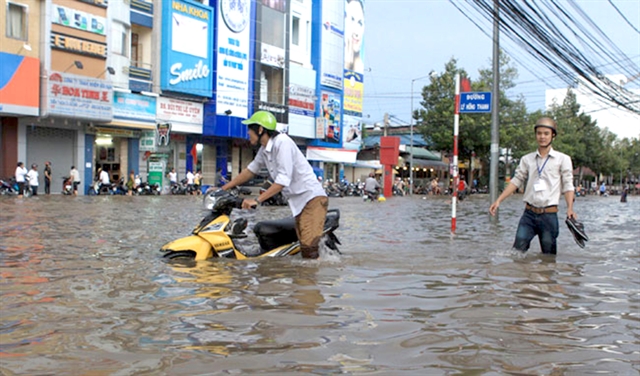 Society
Society

Việt Nam, as one of the most vulnerable countries to climate change, is set to develop a roadmap to implement market-based carbon pricing tools as part of its effort to reduce greenhouse gas (GHG) emissions.

|
| Flood waters submerge Cần Thơ city in the Mekong Delta region. Việt Nam plans to implement market-based carbon pricing tools in an effort to reduce greenhouse gas emissions. — VNA/VNS Photo Duy Khương |
HCM CITY — Việt Nam, as one of the most vulnerable countries to climate change, is set to develop a roadmap to implement market-based carbon pricing tools as part of its effort to reduce greenhouse gas (GHG) emissions.
Nguyễn Tuấn Quang, deputy director of the Climate Change Department under the Ministry of Natural Resources and Environment, said: “Climate change has negatively affected the country’s efforts to reduce poverty and develop sustainably.”
The most vulnerable sectors include water resources, agriculture, food security, and public health, mostly in the deltas and coastal areas.
Việt Nam has shown a strong commitment to green development and environmental protection over the past decade. The country became a member of the United Nations Framework Convention on Climate Change (UNFCCC) in 1994, and ratified the Kyoto Protocol in 2002, he said.
“The Paris Agreement on climate change under the UNFCCC passed in 2015 affirmed the role and legal responsibilities of nearly 200 countries in responding to global climate change, especially reducing Nationally Determined Contributions (NDC),” according to Quang.
In September, the country’s NDC committed to the UNFCCC to reduce GHGs by 9 per cent by 2030 by using domestic resources and by 27 per cent with international support.
To achieve these goals, the country needs to implement market-based carbon pricing tools through a system in which carbon emissions quotas and credits can be exchanged fairly among businesses, according to Quang.
Phạm Trọng Quý Châu, deputy chairman of the Association of Enterprises in Industrial Parks in HCM City, said that developing the carbon market through financial tools such as taxes and carbon trading is an effective measure to reduce GHG emissions.
For developing countries like Việt Nam, participating in the carbon market is an opportunity to generate revenues, access modern low-carbon technology, and join hands with the rest of the world to reduce GHG emissions.
In the long run, companies will benefit from the carbon pricing mechanism. Credits on GHG emission reduction can be sold to other enterprises. Enterprises that discharge excessively must buy credits from other enterprises to meet the requirements according to the law.
The association will provide advice and assistance to businesses in the city to implement the programme, Châu said.
Trần Đăng Khôi, deputy director of Alenna Energy Technology Co., Ltd., recommended setting up a trusted and reputable carbon credit trading floor for enterprises.
“Carbon-emission pricing solutions are expected to open up many new opportunities in environmental protection, forcing enterprises to invest in GHG mitigation or pay to buy carbon credits.”
To build a carbon market, the Government needs to provide more information about technology, policies, and techniques to businesses, he said.
The Ministry of Natural Resources and Environment has proposed adding the carbon market to the revised draft Law on Environmental Protection. The National Assembly is expected to approve the draft law at the upcoming 10th session.
In 2012, Việt Nam joined the Partnership for Market Readiness (PMR) with support from the World Bank. It aims to establish carbon markets in developing, emerging countries like Việt Nam.
Việt Nam recently updated the country’s NDC by increasing its capability to adapt to climate change through better governance and preparedness against natural disasters.
Việt Nam is one of five countries most affected by climate change. If sea levels rise by one metre, one-fifth of the country’s population or some 18 million could become homeless and 12.3 per cent of farmland could disappear, experts have warned. — VNS